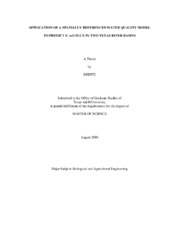Application of a spatially referenced water quality model to predict E. coli flux in two Texas river basins
Abstract
Water quality models are applied to assess the various processes affecting the
concentrations of contaminants in a watershed. SPAtially Referenced Regression On
Watershed attributes (SPARROW) is a nonlinear regression based approach to predict
the fate and transport of contaminants in river basins. In this research SPARROW was
applied to the Guadalupe and San Antonio River Basins of Texas to assess E. coli
contamination. Since SPARROW relies on the measured records of concentrations of
contaminants collected at monitoring stations for the prediction, the effect of the
locations and selections of the monitoring stations was analyzed. The results of
SPARROW application were studied in detail to evaluate the contribution from the
statistically significant sources. For verification of SPARROW application, results were
compared to 303 (d) list of Clean Water Act, 2000. Further, a methodology to maintain
the monitoring records of the highly contaminated areas in the watersheds was explored
with the application of the genetic algorithm. In this study, the importance of the
available scale and details of explanatory variables (sources, land-water delivery and
reservoir/ stream attenuation factors) in predicting the water quality processes were also
analyzed. The effect of uncertainty in the monitored records on SPARROW application
was discussed. The application of SPARROW and genetic algorithm were explored to
design a monitoring network for the study area. The results of this study show that
SPARROW model can be used successfully to predict the pathogen contamination of
rivers. Also, SPARROW can be applied to design the monitoring network for the basins.
Citation
, Deepti (2008). Application of a spatially referenced water quality model to predict E. coli flux in two Texas river basins. Master's thesis, Texas A&M University. Available electronically from https : / /hdl .handle .net /1969 .1 /ETD -TAMU -2878.


